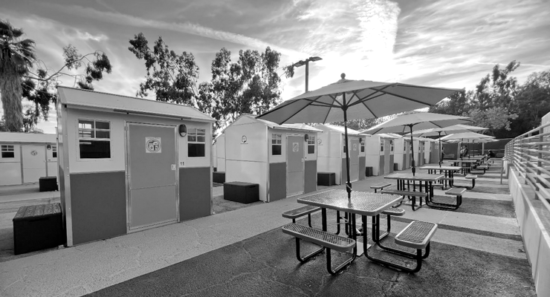
I have been a resident of Pasadena for over 19 years. I am an advocate for persons experiencing homelessness in Pasadena, especially our unsheltered residents. I have also been involved in direct outreach to our unsheltered residents and I have shared a two-year journey with a formerly unhoused resident who, after decades of experiencing homelessness and 19 months in interim housing, is finally receiving a permanent home.
Through my experience I have observed the extremely difficult circumstances our unsheltered endure daily and the substantial obstacles to achieving permanent housing and wellness. I have also learned that our community IS interested in creating a more humane housing situation for our unsheltered residents through conducting two community webinars and circulating a petition for more interim housing in our City.
The Staff Report’s recommendation notes as follows: “This item is for information only; no action is required.” I hope you will disagree. Urgent action to provide basic shelter and services for our nearly 300 unsheltered residents IS required.
I have submitted many letters to you about creating more interim housing for our unsheltered residents, which are part of the public record. Other community members have as well. The purpose of this letter is to address important information that is missing from the June 1, 2022 Staff Report to this Committee.
- The Very Significant Risks Our Unsheltered Residents Endure and the Benefits of Tiny Shelter Communities Need to be Considered by Staff and this Committee
A key discussion missing from the staff presentation is the significant risks of life on the street and how adequate interim housing is necessary to protect our unsheltered residents. This is the reason community members urged that this subject be agendized in the first place.
According to our Housing Department and homeless service providers I have talked to, it can take over one year for a person to move from life on the street to permanent housing. Unsheltered persons are extremely vulnerable due to substantial chronic health conditions; undiagnosed and untreated mental illness; substance use disorders; malnutrition, and/or other substantial problems, including threats to their personal safety. (See 2020 Homeless Count Report, pp. 23-25; see also, 2022 Homeless Count Report, p. 15.) Unsheltered persons face very substantial daily challenges including possible assault and harassment, loss of belongings, health and mental health issues, food insecurity, lack of readily available bathrooms and hygiene services, inclement weather, and transportation difficulties. A Housing Department staff member has stated publicly that “It’s very unsafe on the street. People don’t sleep much.” (12/8/2021 ED Tech Mtg., timestamp 1:16:00.)
Tiny homes as interim housing for unsheltered persons experiencing homelessness, have distinct advantages over scattered-site motel “vouchers,” our City’s primary interim housing model. Some of those benefits/advantages are as follows:
- Intensive onsite case management services (health, mental health, substance use disorder treatment, housing navigation, job counseling)
- Efficient onsite case management services (both client and provider)
- Sense of community
- Continuity of care
- Sense of security knowing there will be shelter and services for more than just a few days • Some sites include a medical professional onsite to assist with medications, etc. • Easy transport to medical, etc. appointments
- Laundry facilities onsite; housekeeping
- Meals delivered onsite
- 24/7 Security
- Cabins available for re-use, unlike motel vouchers; 10-year life cycle
- Tiny homes can be more cost efficient, operationally, than motel vouchers.1
- Critical Quantitative Information on the City’s Motel “Voucher” Program Has Not Been Provided to the Community
At this Committee’s December 8, 2021 meeting, Vice Mayor Wilson asked staff to provide the total number of motel nights, by location, used for interim housing. He stated the City is spending over $2 million and should be tracking where the money is spent. He noted that, if motel vouchers are concentrated in a few motels at a few locations, perhaps we could pursue “ownership change.”
Councilmember Madison stated “[a]t a bare minimum we need to know where every dollar went.” (1:15:00.) Councilmember Hampton agreed that we should know how many room nights were used, and where, and that if staff does not have that information, it should obtain it on a going-forward basis. (1:17:00.)
Information related to the number of motel nights provided is critical to understanding how many unsheltered residents our City is actually providing for, and for how long, and how many are being left on the street with no shelter at all. City staff has not provided any of this information, at least not publicly as requested by community members.
Significantly, the Staff Report states that due to the COVID-19 pandemic, the City’s congregate shelters have had to reduce their capacities by up to 75%. “Thus, the need for new, non congregate interim or ‘bridge’ housing has grown more urgent.” (Staff Report, p. 1.) Additionally, in the December 6, 2021 response to my second PRA request (submitted November 2, 2021), staff stated the following: “. . .[T]he City does not have sufficient resources to meet the shelter needs of all who need it on a nightly basis. Motel vouchers for everyone is not a viable or practical solution for several reasons. Scattered-site, motel-based shelter without on-site services is not a shelter model that appropriately meets the needs of all unsheltered persons. A variety of shelter models, including congregate shelters and transitional housing for certain populations, is needed to meet the varying needs of the City’s homeless population.”
Thus, Staff has clearly advised you, at least generally, that the motel voucher program is inadequate. Staff notes in the PowerPoint that the City is in the process of developing an updated Homelessness Plan. The Pasadena Continuum of Care Homelessness Plan was last updated in June of 2019! The current update is not expected to be completed until December and is purportedly going to serve as a guiding document for planning, funding and coordination of homeless services in the future. In the meantime, and even though staff admits that the City’s interim housing is currently inadequate, are our most vulnerable residents expected to just “hang out” on the “very unsafe” streets?
- Staff Has Thus Far Not Provided Information Requested re: Possible Sites for a Tiny Home Village
At this Committee’s March 15, 2022, meeting, staff presented a list of City-owned vacant properties in response to Vice Mayor Wilson’s request for a list of City-owned properties that could potentially be available for a tiny shelter community. Committee members discussed the sites listed, especially the first site. Per the minutes from the meeting, “Chair Hampton asked Jeffrey Hernandez, Real Property Manager to compile expiring leases of City owned buildings/office spaces (non-public benefit leases) and to extend his outreach efforts to owners of vacant lots/buildings (residential and commercial).” Per those same minutes “Mr. Klug stated he intends to speak with the Interim City Manager regarding tiny shelters and return to the Committee with an update. The Chair stated he would like the agenda report at the next scheduled Committee meeting in April 2022.” To my knowledge, none of the information requested by Chairperson Hampton has been publicly presented.
3
As the Staff Report notes, from a local zoning perspective, tiny shelter communities qualify as “Low Barrier Navigation Centers,” which are statutorily defined as “a Housing First, low-barrier, service-enriched shelter focused on moving people into permanent housing that provides temporary living facilities while case managers connect individuals experiencing homelessness to income, public benefits, health services, shelter and housing.” (Gov. Code, § 65660, subd. (a).) Low Barrier Navigation Centers enjoy a use by right in areas zoned for mixed use and nonresidential zones permitting multifamily uses, if it meets certain criteria as specified in the statute. (Gov. Code, § 65662.) According to Planning Director David Reyes, much of Pasadena is zoned as mixed use which suggests that a tiny shelter community could be developed, by right, in many places in Pasadena. And, as noted in the Staff Report, another option available to the City to create more interim housing is declaring a “shelter crisis.”
- The Possible Funding of a Tiny Home Village Needs to be Presented and Considered
An obvious consideration in creating more interim housing, but missing from the Staff Report, is funding. Before our leaders and community members can determine whether our City is doing enough to shelter our unsheltered residents and whether the City can and should do more, we need to know what the City is actually funding, if anything. Our community is entitled to transparency on this issue.
According to the Housing Department’s July 12, 2021 response to my first PRA request, the Department’s FY 2022 Adopted Budget “includes $835,344 for motel vouchers and other interim housing.” The chart the Department provided me showed that none of those funds are from city generated revenues. And when the City received $26 million last year from the federal government in American Rescue Plan Act (ARPA) funds, the Council allocated more money for the traffic signal at Orange Grove Boulevard and Craig Avenue than for interim housing for our unsheltered neighbors. Significantly, at the August 16, 2021 City Council meeting, Councilmember Hampton “asked staff to provide initiatives to address rental assistance, housing, homelessness and housing vouchers when the second installment of ARPA funds are issued to the City.” (Minutes of the meeting.)
A tiny home village can be funded with some of the $26 million in American Rescue Plan Act funding our City received this year, $20 million of which is not yet appropriated.2 Additionally, apart from the ARPA funds, the City Council can find funding to provide basic shelter for our unsheltered neighbors just like it found funding for a helicopter camera surveillance system to replace a functioning system, to replace a functioning mobile command center, and $21.5 million to cover the debt on the Rose Bowl the past two years. We have the funds for the upfront capital costs of a tiny shelter as well as additional funds for operating costs. The City
2 While the Housing Department is receiving $3 million in ARPA funding, that funding is earmarked for affordable housing projects, not interim housing. Moreover, without that $3 million appropriation from the federal government, the FY 2023 Recommended Housing Department Budget of $39,307,500 would
be $4.35 million lower than the FY2022 adopted budget instead of the lesser amount of $1.35 million. 3 According to the Interim Final Rule, which provides guidance for allocating the federal ARPA funding, the creation of a tiny shelter community would be an eligible use since it provides a critical program that our most vulnerable residents need to move forward from the pandemic.
CAN provide funding to alleviate human suffering experienced by persons living on the street. Our City leaders need to take urgent action to do so.
- Conclusion
The Staff Report concludes with the following: “The Department will evaluate potential tiny village opportunities as they may arise and bring such projects to City Council for consideration as appropriate.” I hope you will agree that this vague, tenuous “plan” is unacceptable. Our City can no longer ask our most vulnerable residents to “hang out” on the “very unsafe” street. Other cities in Southern California and beyond have actively sought out opportunities for tiny home villages, have helped develop them, and have funded them sometimes with the assistance of the State or local government. Please do not determine that “no action is required” as recommended by Staff. Rather, ensure that the City does everything in its power to ensure that more interim housing is created in our City through tiny home villages and through converted motels. Thank you for your time and consideration of this letter.
Sonja Berndt














 0 comments
0 comments


